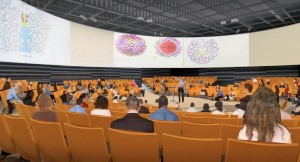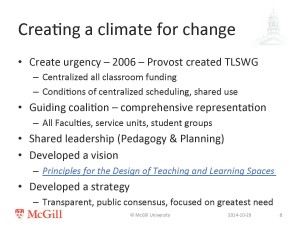As many of our peer institutions build new buildings or renovate existing ones, more attention is being paid to questions of universal classroom design—that is, inclusive learning spaces that can be used for multiple teaching and learning modalities. Innovations include flexible seating arrangements, the strategic placement of additional projectors, screens and whiteboards, improved sound design for large active classrooms, and improved processes for renovation and design that better involve all campus stakeholders. The result is an improved experience for learners of all abilities. Read on for three inspiring examples!
Principles of Universal Design
The seven principles of universal design—a concept that originated in the fields of architecture and environmental design—are as follows:
- Equitable use. The design supports users with diverse abilities, including the disabled.
- Flexibility in use. The design supports user preferences for customization and personalization.
- Simple and Intuitive. The design is easy to understand and feels native to many users, regardless of prior knowledge or experience.
- Perceptible Information. The design communicates information effectively to all users regardless of individual sensory abilities.
- Tolerance for Error. The design minimizes hazards and adverse consequences.
- Low Physical Effort. The design is comfortable and efficient.
- Size and space for approach and use. All important aspects of the design are usable by all, regardless of body size, posture, or mobility.
When applied to classroom design, particularly in higher education, universal design principles encourage the creation of flexible spaces that can accommodate both a variety of teaching styles and a variety of learning styles. The results are often active learning spaces, even when they are meant for use by a large number of students at one time. Furthermore, the application of these principles during the design and development process encourages community engagement.
Noteworthy Examples
Here are three exciting models of classroom (re)design at North American colleges and universities. All three take at least some of the principles of universal design into account.
Our friends at Oregon State University are currently building a new Classroom Building – Learning Innovation Center (LInC), which will house their Integrated Instructional Resource Center and includes a number of innovative classroom technology and layout designs. The classroom designs were developed with faculty input–a process which included a full practice mock-up of one of their more innovative large-scale spaces, a “teaching in the round” arena classroom. When finished, that hall will seat 600, but each student will be no more than six rows away from the central stage, allowing for better engagement with the faculty member leading the course. The LInC building will also include a wide variety of other learning spaces, formal and informal, when it opens in Fall 2015.

Note the microphones dropped from the ceiling and the strategic screen placement across Lathrop 282.
When Stanford University renovated Lathrop Library, they restructured one of the largest classrooms in the building, Lathrop 282. A 3,000 square foot classroom that seats 140 students, Lathrop 282 now utilizes Constellation, an advanced sound system of scores of hanging microphones and small speakers that allow for finely-honed control of the rooms acoustics. A touch-screen system lets the instructor set the best sound for small group work, lecture, or discussion. The sound system is complemented by the use of flexible, table-based seating and strategic screen placement.
In 2006, McGill University created a centralized Teaching and Learning Spaces Working Group (TLSWG), which coordinates and prioritizes all funding for classroom renovations on campus. TLSWG includes both academic and operational stakeholders; decisions are based upon on an agreed-upon set of pedagogical principles. Since its founding the TLSWG has overseen improvements in over 350 classrooms and has helped make the physical learning environment a campus priority.



